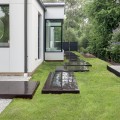Minimalist Landscape Design

Minimalist landscape design is based upon the aesthetic principle of “less is more”. Currently, it is most commonly associated with contemporary landscape design due to the modernist reduction of vegetation and the emphasis of inorganic elements over organics. However, minimalism has been around since Classical times in one form or fashion and has continued to evolve and diversify over the past 2,000 years in all Western garden and landscape designs. As such, it can be applied to virtually any property with equal success provided a skilled professional landscape company is contracted to develop these principles in harmony with home architecture, lot size, and outdoor living needs.
Gardens
Much of the success of a minimalist landscape design is going to depend upon the aesthetic of the garden(s) planted in the front or back yard. Overdoing a garden with too many plants and flowers is the one thing that will make the landscape itself look choked, crowded, and too much for the eye to handle.
It is much more practical from both an aesthetic perspective and from an outdoor living perspective to think of a garden as an outdoor room. This is not hard to conceptualize once a person does away with the mental image of a “room” being a closed-in space surrounded by traditional walls. Walls in a garden can be anything from small architectural masonry walls to rows of Yew or Japanese Maples up lighted by landscape lights. The key is to carefully select plants that will stand out as individual elements that share a common theme of interconnectedness when viewed as a whole. Spacing and geometry are much more important here than crowding lots of different plants together like a miniature jungle of greenery and color.
Architectural Walls
Masonry is every important to minimalist landscape design, and is perhaps the one element other than hedges that has survived since ancient times. Greeks and Romans almost always incorporated stone walls into their estates and gardens as a symbol of man’s control of nature. To this day, stone remains a popular building material for both small and large courtyard walls. However, the cost factor of building in stone has definitely NOT gone down in the past two millennia. More affordable options in brick are available that can produce superb results at a much lower costs.
The materials selected should always act as a backdrop for the vegetation and ornaments that are installed in the garden. Both colors and geometric patterns should work together to create the sense of a unified environment where inorganic forms contain and direct the flow of organic energy without overwhelming the senses. Such control is the essence of all minimalist landscape designs, be they historical, contemporary, or cultural in nature.
Custom Patios
Custom patios are essential to minimalist landscape design because they act like outdoor floors for gatherings. No one wants to sit or stand on dirt when they go outside to enjoy an evening. Patios can be built from stone, concrete, brick, even wood to create a solid surface that supports human transit. Just as important, patios occupy space that would otherwise be filled with vegetation, so they are crucial to limiting the amount of greenery and floral color to just the right amount for the intended effect of the setting.
Water elements
Water features such as fountains, reflecting pools, and natural ponds that are used to center the focus of people sitting in a garden area. A well-lit water feature at night can fill space without taking ups space, so to speak, and do much to make the less-is-more nature of minimalist landscape design appear sublime and often mystical to the senses.
Most people get themselves into trouble by calling a swimming pool contractor to have a new pool installed or an old pool remodeled. This will never work with a minimalist landscape design because pool companies are not trained in the architectural and botanical disciplines that are required to bring all the many features of the landscape into the appropriate proportions to support a less-is-more theme. The pool will inevitably be either too large, or in some cases, too small to compliment the garden elements, custom hardscapes, and careful masonry constructs that define the outdoor living space.
Swimming pool design should always be handled by the landscaping company, who can then outsource the specifications for the size and geometry of the pool to a partner pool company.





